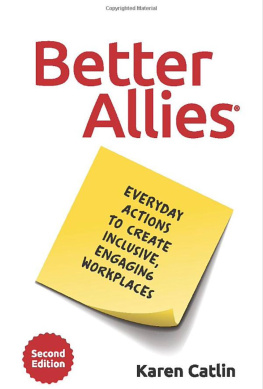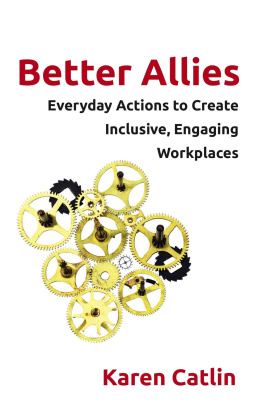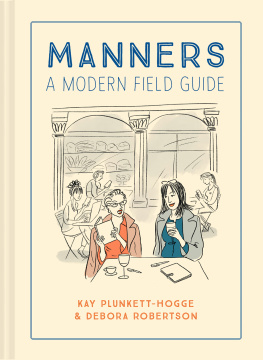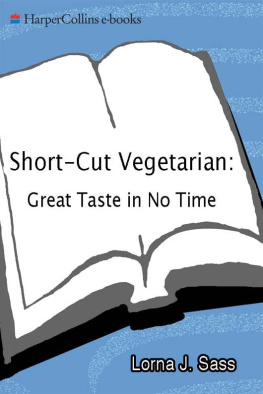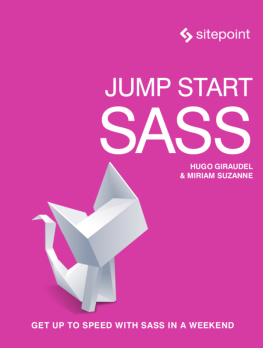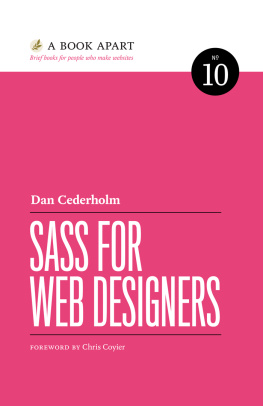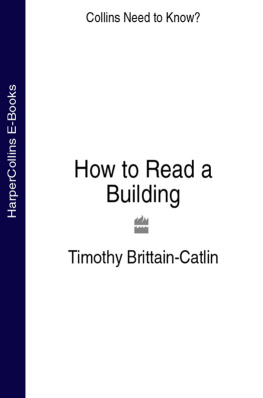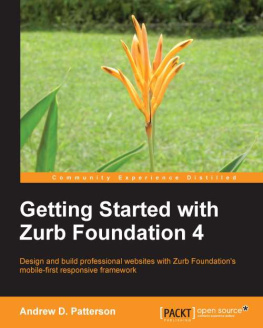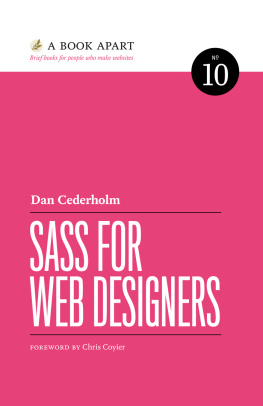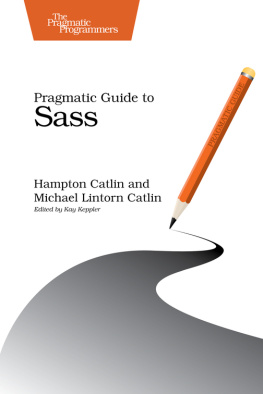Catlin Hampton Lintorn - Pragmatic Guide to Sass 3: Tame the Modern Style Sheet
Here you can read online Catlin Hampton Lintorn - Pragmatic Guide to Sass 3: Tame the Modern Style Sheet full text of the book (entire story) in english for free. Download pdf and epub, get meaning, cover and reviews about this ebook. year: 2016, publisher: Pragmatic Bookshelf, genre: Home and family. Description of the work, (preface) as well as reviews are available. Best literature library LitArk.com created for fans of good reading and offers a wide selection of genres:
Romance novel
Science fiction
Adventure
Detective
Science
History
Home and family
Prose
Art
Politics
Computer
Non-fiction
Religion
Business
Children
Humor
Choose a favorite category and find really read worthwhile books. Enjoy immersion in the world of imagination, feel the emotions of the characters or learn something new for yourself, make an fascinating discovery.

- Book:Pragmatic Guide to Sass 3: Tame the Modern Style Sheet
- Author:
- Publisher:Pragmatic Bookshelf
- Genre:
- Year:2016
- Rating:5 / 5
- Favourites:Add to favourites
- Your mark:
- 100
- 1
- 2
- 3
- 4
- 5
Pragmatic Guide to Sass 3: Tame the Modern Style Sheet: summary, description and annotation
We offer to read an annotation, description, summary or preface (depends on what the author of the book "Pragmatic Guide to Sass 3: Tame the Modern Style Sheet" wrote himself). If you haven't found the necessary information about the book — write in the comments, we will try to find it.
Pragmatic Guide to Sass 3: Tame the Modern Style Sheet — read online for free the complete book (whole text) full work
Below is the text of the book, divided by pages. System saving the place of the last page read, allows you to conveniently read the book "Pragmatic Guide to Sass 3: Tame the Modern Style Sheet" online for free, without having to search again every time where you left off. Put a bookmark, and you can go to the page where you finished reading at any time.
Font size:
Interval:
Bookmark:
Copyright 2016 The Pragmatic Programmers, LLC. This book is licensed to the individual who purchased it. We don't copy-protect it because that would limit your ability to use it for your own purposes. Please don't break this trustyou can use this across all of your devices but please do not share this copy with other members of your team, with friends, or via file sharing services. Thanks.
Many of the designations used by manufacturers and sellers to distinguish their products are claimed as trademarks. Where those designations appear in this book, and The Pragmatic Programmers, LLC was aware of a trademark claim, the designations have been printed in initial capital letters or in all capitals. The Pragmatic Starter Kit, The Pragmatic Programmer, Pragmatic Programming, Pragmatic Bookshelf and the linking g device are trademarks of The Pragmatic Programmers, LLC.
Every precaution was taken in the preparation of this book. However, the publisher assumes no responsibility for errors or omissions, or for damages that may result from the use of information (including program listings) contained herein.
The Pragmatic Bookshelf is an agile publishing company. Were here because we want to improve the lives of developers. We do this by creating timely, practical titles, written by programmers for programmers.
Our Pragmatic courses, workshops, and other products can help you and your team create better software and have more fun. For more information, as well as the latest Pragmatic titles, please visit us at http://pragprog.com.
Our ebooks do not contain any Digital Restrictions Management, and have always been DRM-free. We pioneered the beta book concept, where you can purchase and read a book while its still being written, and provide feedback to the author to help make a better book for everyone. Free resources for all purchasers include source code downloads (if applicable), errata and discussion forums, all available on the book's home page at pragprog.com. Were here to make your life easier.
Want to keep up on our latest titles and announcements, and occasional special offers? Just create an account on pragprog.com (an email address and a password is all it takes) and select the checkbox to receive newsletters. You can also follow us on twitter as @pragprog.
If you buy directly from pragprog.com, you get ebooks in all available formats for one price. You can synch your ebooks amongst all your devices (including iPhone/iPad, Android, laptops, etc.) via Dropbox. You get free updates for the life of the edition. And, of course, you can always come back and re-download your books when needed. Ebooks bought from the Amazon Kindle store are subject to Amazon's polices. Limitations in Amazon's file format may cause ebooks to display differently on different devices. For more information, please see our FAQ at pragprog.com/frequently-asked-questions/ebooks. To learn more about this book and access the free resources, go to https://pragprog.com/book/pg_sass3, the book's homepage.
Thanks for your continued support,
Dave Thomas and Andy Hunt
The Pragmatic Programmers
The team that produced this book includes: Brian P. Hogan (editor) Potomac Indexing, LLC (indexer) Nicole Abramowitz (copyeditor) Gilson Graphics (layout) Janet Furlow (producer)
For customer support, please contact .
For international rights, please contact .
Sass is the abstraction that CSS needs. You would do well to learn it, and learn it well, by reading this book.
| Chris Coyier |
| Creator, CodePen |
How better to learn about the features of Sass than from the guy who came up with it in the first place? Hampton, along with Michael, do a fantastic job of explaining the basics of Sass, then they go all the way up to the more advanced features. They even show some of the new, modern frameworks and techniques to help take Sass further. Definitely worth a read for beginners and advanced Sass developers alike.
| Jina Bolton |
| Lead designer, Salesforce Lightning Design System |
Pragmatic Guide to Sass 3 is the quintessential book on Sass written by two of the only authors qualified to write such a definitive work. If you are new to Sass, this is the first book that you should read. If you are a Sass veteran, this book will become your go-to reference guide.
| Micah Godbolt |
| Author, Frontend Architecture for Design Systems |
Sass is one of the most exciting web technologies to date, and whether you are brand-new to front-end development or a seasoned veteran of the web, youll gain an in-depth look at the intricacies of how Sass works and all of its latest features in this book. Pragmatic Guide to Sass 3 is a must-read for web developers and designers of all stripes.
| Smith Schwartz |
| UX engineer and Sasstronaut |
Acknowledgments
Writing this edition has been a joy, no doubt due to our editor, Brian Hogan, and managing editor, Susannah Pfalzer. The whole Pragmatic Programmers team makes it a wonderful experience to write a book.
Wed like to thank our tech reviewers: Nick Capito, Javier Collado, Peter Hampton, Nick McGinness, Nouran Mhmoud, Stephen Orr, Loren Sands-Ramshaw, Matthew Sullivan, Mitchell Volk, and Matthew White.
Hampton: Sass wouldnt exist today without Natalie Weizenbaum and Chris Eppstein. Their hard work and determination have made Sass the powerhouse developer tool that it is today.
Michael: I cant thank the Sass community enough. Its a pleasure to be part of such a supporting and welcoming group of people.
Welcome!
Welcome to the Pragmatic Guide to Sass 3 . Sass (Syntactically Awesome Style Sheets) enables you to do amazing things with your style sheets and write more efficient, beautiful, and maintainable code.
Whats wrong with regular ol CSS? we hear you cry. The fact is that CSS, with all its power and elegance, is not designed for developer productivity. Instead, its focused on helping the browser quickly display styles as simply as possible. Theres nothing wrong with that, but its not helpful for us as developers. Thats where Sass comes into extend CSS, adding new features and syntax focused on making your life as a developer easier.
Sass isnt a replacement for CSSits a way to help us write better CSS files, which is essential for large projects. Sass helps us write clear, semantic style sheets. Sass updates our CSS development for the future. Its why our motto is CSS with Superpowers.
Sass is by far the most popular of the CSS extension languages, according to almost every survey. Its used in almost every major web project and is the basis for most modern open source style frameworks.
Sass was originally conceived in 2006 as a component of the Haml templating language, and it was the first CSS extension language. It was initially envisaged by Hampton Lintorn Catlin, but it was primarily implemented by Natalie Weizenbaum, who has also been primarily responsible for the languages advanced features and serves as the primary language designer today. Chris Eppstein rounds out the language core team, being best known for Compass and Eyeglass, two popular Sass-related projects. Well talk more about Eyeglass later. Sass has grown up a lot since that original concept! In fact, there are now multiple implementations of Sass, and its available on most platforms.
Font size:
Interval:
Bookmark:
Similar books «Pragmatic Guide to Sass 3: Tame the Modern Style Sheet»
Look at similar books to Pragmatic Guide to Sass 3: Tame the Modern Style Sheet. We have selected literature similar in name and meaning in the hope of providing readers with more options to find new, interesting, not yet read works.
Discussion, reviews of the book Pragmatic Guide to Sass 3: Tame the Modern Style Sheet and just readers' own opinions. Leave your comments, write what you think about the work, its meaning or the main characters. Specify what exactly you liked and what you didn't like, and why you think so.

